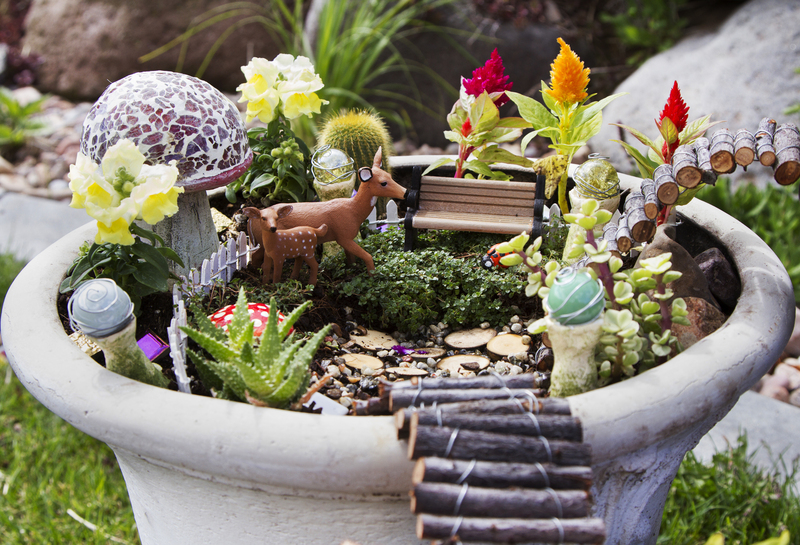Delight in Outdoor Solitude with Zen Garden Techniques
Posted on 22/08/2025
Delight in Outdoor Solitude with Zen Garden Techniques
If you crave tranquility and a deeper connection to nature, transforming your backyard or patio into a personal haven of calm is easier than you think. By embracing Zen garden techniques, you can create a serene outdoor space that encourages mindfulness and celebrates solitary moments. Discover below how to design, implement, and maintain a peaceful Zen garden where you can truly relish the beauty of outdoor solitude.

Understanding Zen Gardens: A Tradition Rooted in Mindfulness
Originally developed in ancient Japan, Zen gardens--also called "karesansui," or dry landscape gardens--are designed to inspire contemplation and meditation. Traditionally, these spaces are characterized by simplicity, balance, and symbolism. Their purpose is not just aesthetic, but also spiritual: a place to delight in solitude, embrace the present moment, and gain insights into the order and beauty of the natural world.
- Simplicity: The minimalist approach avoids clutter, using few elements to create maximum impact.
- Symbolism: Every aspect of a Zen garden, from rocks to raked gravel, represents aspects of nature like mountains, rivers, and islands.
- Balance: Each component is carefully arranged to produce visual harmony and evoke a tranquil atmosphere.
Why Choose a Zen Garden for Outdoor Solitude?
Many modern lifestyles are filled with noise and distraction. Creating a Zen-inspired outdoor area allows you to have:
- A dedicated spot for mindfulness and self-reflection.
- A natural stress-relieving sanctuary right at home.
- An easy-to-maintain outdoor retreat that looks beautiful year-round.
- Opportunities to practice meditation, yoga, or simply enjoy silence in a personal oasis.
With the right Zen garden techniques, even a small backyard or balcony can be transformed into your favorite place to delight in outdoor solitude.
Principles and Techniques of Zen Garden Design
To capture the essence of these sacred Japanese gardens, consider these fundamental Zen design principles for your outdoor space:
1. Embrace Asymmetry and Natural Flow
Unlike Western gardens that may favor symmetry, Zen garden techniques often utilize uneven shapes and non-linear patterns. This approach echoes nature's own unpredictability and helps you focus on natural beauty.
2. Simplicity Above All
The heart of a Zen garden is its simplicity. Use only the essential elements:
- Rocks and stones
- Sand or gravel for raking
- Moss and minimal foliage
- Water features (either present or implied through symbolism)
3. Thoughtful Placement of Elements
Contents of a Zen garden are carefully arranged to create meaning and balance, with rocks representing mountains or islands, and raked gravel symbolizing water currents.
4. Use Negative Space
Ma, or the use of empty space, is vital. The open areas between rocks or plants inspire the viewer to appreciate what is present and what is left unsaid, paving the way for contemplation and outdoor solitude.
5. Subtle Colors and Textures
Choose a muted color palette--grays, greens, and earth tones--to promote calmness and avoid visual clutter.
Step-by-Step: Creating Your Own Zen Outdoor Retreat
Ready to build a garden that invites you to unwind alone and connect inward? Follow these essential steps for implementing Zen garden techniques:
Step 1: Choose the Right Spot
- Pick a quiet part of your yard, patio, or balcony.
- Consider natural light, privacy, and noise level.
- If possible, find a place visible from your favorite indoor spot so the serenity extends inside your home.
Step 2: Plan the Layout
- Sketch your space, noting sun/shade areas and any pre-existing elements (like trees or fences).
- Keep the design minimal but purposeful: remember, less is more.
- Decide where each major feature goes--such as rocks, sand patches, or stepping stones.
Step 3: Select the Key Elements
Cornerstones of a Zen garden include:
- Rocks: Choose different sizes and shapes. Position them singly, in pairs, or triads--odd numbers are favored for natural aesthetics.
- Gravel or Sand: Rake designs to represent water flow; patterns can be changed according to mood and season.
- Moss and Ground Covers: These add soft color and texture while requiring minimal care.
- Minimalist Plants: Use bamboo, Japanese maples, dwarf pines, or evergreens sparingly.
- Water Features: If space allows, a small pond, stone basin, or symbolic water arrangement enhances tranquility.
Step 4: Assemble with Care and Intention
- Arrange stones and rocks first (the "bones" of your garden).
- Spread gravel or sand, raking gently into your desired patterns.
- Add select plants and any water features.
- Incorporate simple seating--a wooden bench, stone slab, or meditation cushion--so you can comfortably delight in your outdoor solitude.
Step 5: Maintain and Evolve Your Garden
- Spend time regularly raking gravel and tending to plants; this process is meditative and anchors you in the present.
- Remove debris and fallen leaves to keep the garden uncluttered.
- Feel free to rearrange elements seasonally, or as your intuition guides you.
Zen Garden Techniques to Deepen Solitude and Mindfulness
The real magic of a Zen garden emerges as you learn to use the space as intended: for reflection and solitude. Try these techniques to heighten your experience:
- Intentional Walks: Slowly walk through your garden, observing each detail. Allow your mind to clear and embrace mindful breathing.
- Evolving Patterns: Change gravel patterns in the sand both as art and meditation. Let the act calm your thoughts.
- Sit in Stillness: Take a seat, close your eyes, listen to nature's sounds, and delight in the peaceful solitude your Zen garden offers.
- Read or Journal: Bring your favorite book or a notebook, making the garden your outdoor reading nook or gratitude journal space.
- Seasonal Observations: Watch over the months how light, shadow, and weather transform your garden--inviting a deeper connection to time's flow.
Adapting Zen Garden Techniques for Any Outdoor Space
You don't need a sprawling backyard or unlimited resources to create a Zen retreat. With a few simple techniques, you can bring tranquility to even the smallest spaces:
- Container Zen Gardens: Use large bowls, planters, or trays filled with sand, pebbles, and a few stones for tabletop tranquility.
- Balcony or Rooftop Zen Corners: Combine a small patch of gravel, potted bamboo, and a stone lantern to establish a restful nook.
- Minimalist Pathways: Lay stepping stones through existing lawn or flowerbeds to hint at a Zen aesthetic and encourage slow, mindful walking outdoors.
Eco-Friendly and Sustainable Zen Gardens
For those wishing to make their Zen retreat environmentally friendly:
- Choose local rocks and materials to minimize carbon footprint.
- Select drought-tolerant plants, requiring less water and care.
- Use solar-powered water features and recycled materials where possible.
Popular Zen Garden Accessories: Elevate Your Outdoor Solitude
Enhance the atmosphere of your Zen-inspired outdoor haven with a few thoughtful accessories:
- Stone Lanterns (Ishidoro): Add a classic Japanese motif that also helps guide your evening wanderings.
- Bamboo Fountains (Shishi-odoshi): Provide soothing sound and visual interest.
- Meditation Benches: Choose natural wood or stone for seating that blends with the environment.
- Wind Chimes: Hang subtle, melodic chimes to further invite a meditative mood.
- Garden Sculptures: Simple Buddha statues or abstract forms can provide inspiration for quiet contemplation.
Benefits: Why Zen Gardens Inspire Delight in Outdoor Solitude
- Reduced Stress: The act of creating and tending a Zen garden is inherently calming.
- Increased Mindfulness: Repeated tasks like raking the gravel or pruning promote presence and awareness.
- Aesthetic Pleasure: Minimalist beauty is always in season.
- Personal Sanctuary: Your space becomes a retreat from everyday demands, making it easier to return invigorated.
- Healthier Lifestyles: Even gentle outdoor activity supports well-being, and the garden itself encourages contemplative practices like meditation and gentle movement.
Common Challenges and Their Solutions
While the essence of a Zen garden is simplicity, you may face obstacles as you bring your own tranquil haven to life. Here's how to address a few common issues:
- Limited Space: Choose smaller rocks and sand patches, or try a portable container garden. Focus on quality over quantity.
- High Maintenance: Avoid high-maintenance plants. Opt for moss and slow-growing ground covers instead.
- Budget Constraints: Use locally-sourced stones and repurpose existing materials to reduce expenses.
- Pest or Wildlife Issues: Select non-palatable plants and incorporate protective mesh if necessary.

Conclusion: Embrace the Art of Solitude with Zen Garden Techniques
In a world that never stops, giving yourself permission to be still may be the greatest gift of all. Delight in your own outdoor solitude by crafting a Zen-inspired retreat that nurtures reflection, mindfulness, and joy. Whether in a large yard or on a modest balcony, even the smallest garden cultivated with Zen garden techniques provides a timeless place for peace--an oasis that's always waiting for you to return and restore your spirit.
Commit today to begin your journey into outdoor tranquility. Let the principles and practices of Zen gardening guide you, and discover how a simple, mindful space can profoundly enrich your daily life.
FAQs: Delight in Outdoor Solitude with Zen Garden Techniques
- Can I create a Zen garden in a very small space?
Absolutely. A tabletop or container Zen garden is perfect for apartments, small patios, or balconies. - Do Zen gardens require a lot of maintenance?
No. They're designed to be low-maintenance, needing only occasional raking, pruning, and cleaning. - Which plants are best for a Zen garden?
Moss, bamboo, Japanese maples, evergreens, and ferns are commonly used for their beauty and simplicity. - How do I maximize solitude in my Zen garden?
Add natural screens (bamboo, fencing), avoid digital distractions, and designate the space solely for quiet time or meditation.
Transform your outdoor area into a sanctuary of peace and presence. Step outside, slow down, and delight in outdoor solitude with timeless Zen garden techniques.

